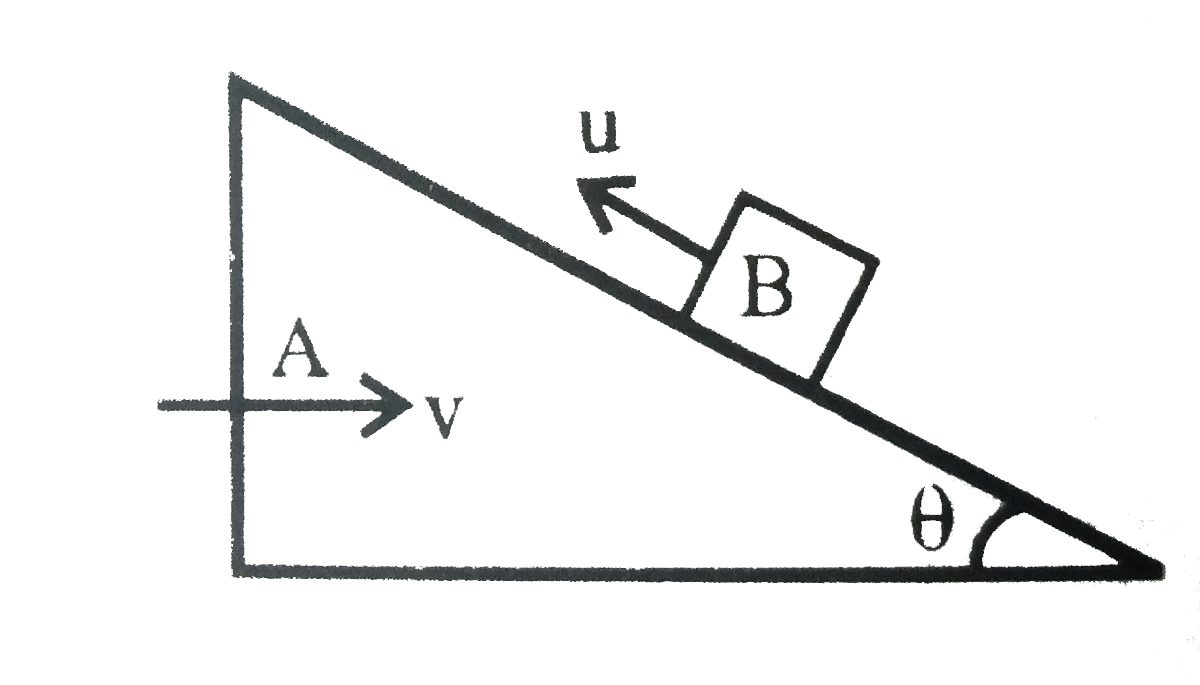A wedge is placed on a smooth horizontal plain and a rat runs on its sloping side. The velocity of the wedge is v=4ms−1 towards the right. What should be the velocity of the rat with respect to the wedge (u), so that the rat appears to ,move in the vertical direction to an observer stading on the ground?

2m/s
4m/s
8m/s
4√2m/s
The correct Answer is:c
→vr=→vrw+→vw
vu=cosθ
⇒u=vcosθ=4cos60∘=8m/s

Topper's Solved these Questions
- MOTION IN TWO DIMENSIONBook:A2ZChapter:MOTION IN TWO DIMENSIONExercise:Assertion Reasoning
Explore 11 Videos
- MOTION IN TWO DIMENSIONBook:A2ZChapter:MOTION IN TWO DIMENSIONExercise:NEET Questions
Explore 16 Videos
- MOTION IN TWO DIMENSIONBook:A2ZChapter:MOTION IN TWO DIMENSIONExercise:Kinematics Of Circular Motion
Explore 26 Videos
- MOCK TESTBook:A2ZChapter:MOCK TESTExercise:Motion With Constant Acceleration
Explore 15 Videos
- NEWTONS LAWS OF MOTIONBook:A2ZChapter:NEWTONS LAWS OF MOTIONExercise:Chapter Test
Explore 30 Videos
Similar Questions
A ball of mass m moving horizotally which velocity u hits a wedge of mass M. The wedge is situated on a smooth horizontal source. If after striking with wedge the ball starts moving in vertical direction and the wedge starts moving in horizotal plane. calculate
a. the velocity of wedge V.
b. the velocity (v) at which the ball moves in vertical direction.
c. the impulse imparted by the ball on the wedge.
d. the coefficient of restitution e=?
View Solutiona. A rail road flat car of mass M can roll without friction along a straight horizontal track . Initially, a man of mass m is standing on the car which is moving to the right with speed v0. What is the change in velocity of the car if the man runs to the left so that his speed relative to the car is vrel just before he jumps off at the left end?
b. If there are n men each of mass m on the car, should they all run and jump off together or should they run and jump one by one in order to give a greater velocity to the car?

View Solution
Knowledge Check
A car is moving on horizontal ground with a velocity vm s−1 with respect to earth. The driver of the car observes the rain to be falling vertically downwards with velocity 2vm s−1 . What is the velocity of the rain with respect to the driver ?
A3vBv√3Cv√5Dnone of these
A block is placed on a smooth wedge of inclination angle θ with the horizontal. What minimum acceleration should be given to the wedge in the horizontal direction so that the block starts moving up along the incline?A>gcotθB>>anθC>gsinθD>gcosθ
The block B moves with a velcoity u relative to the wedge A. If the velocity of the wedge is v as shown in figure, what is the value of θ so that the block B moves vertically as seen from ground.

View SolutionA smooth wedge of mass M rests on a smooth horizontal surface. A block of mass m is projected from its lowermost point with velocity v0. What is the maximum height reached by the block?

View SolutionThis figure shows a man of mass m standing at the end A to a trolley of mass M placed at rest on a smooth horizontal surface. The man starts moving towards the end B with a velocity urel with respect to the trolley. The length of the trolley is L.

(a) Find the time taken by the man to reach the other end.
(b) As the man walk on the trolley, find the velocity centre of mass of the system (man+trolley).
(c) When the man reaches the end B, find the distance moves by the trolley with respect to ground.
(d) Find the distance moved by the man with respect to ground.
View Solution5 A sphere of radius R is in contact with a R wedge. The point of contact is from the ground as shown in the figure. Wedge is moving with velocity 20ms-1 towards left then the velocity of the sphere at this instant will be 20m/s R15
View SolutionA block of mass 1kg 'is pushed towards a movable wedge of mass 2kg and height h=30cm, with a velocity u=6ms. Before striking the wedge it travels 2m on a rough horizontal portion. The velocity is just sufficient for the block to reach the top of the wedge. Assuming all the surfaces are smooth except the given horizontal part and collision of block and wedge is jerkless, the friction coefficient of the rough horizontal part is (Round off the answer to two decimal places)
'(##CEN_KSR_PHY_JEE_C08_E01_015_Q09##)'
View Solution
A heavy ball of radius R is travelling on a smooth horizontal surface with a velocity of u0 towards left. A horizontally moving small ball of mass m strikes it at a height R2 above the centre while travelling with velocity u towards right.
(a) After collision the small ball moves in vertically upwards direction with velocity u. Prove that this can happen only if u>√3u0
(b) Find the velocity of small ball after collision if the collision is elastic and the balls are smooth.
View Solution

